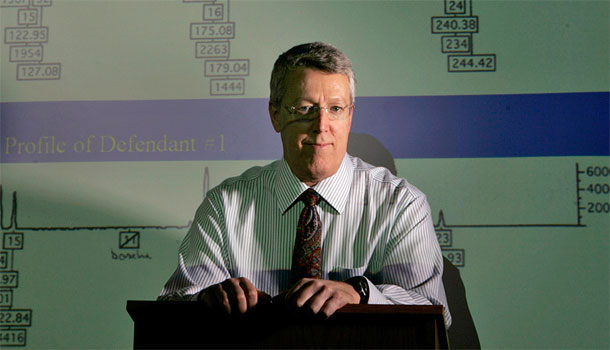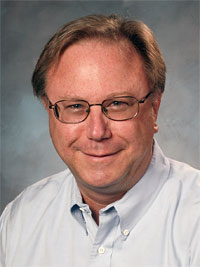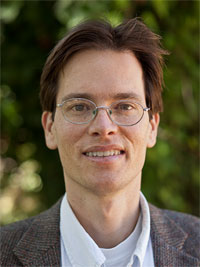
UC and national labs tackle pressing safety issues with innovative research
Tuesday 16 October 2012
A unique collaboration between a law professor and chemist to use forensic science to investigate potential weapons of mass destruction and a novel way to monitor carbon emissions in urban areas are among new projects funded by the UC Laboratory Fees Research Program.
It’s not easy find the expertise needed to assess the accuracy of decisions around weapons of mass destruction (WMD) or to measure infinitesimal amounts of atmospheric gases. Failing to accomplish either could jeopardize our safety.
But researchers at the University of California and Los Alamos and Livermore national laboratories are pooling their unique strengths and applying them to such pressing challenges as national security, greenhouse gases and alternative energy.
The UC Laboratory Fees Research Program was created in 2008 to boost support for collaborations among UC faculty, their graduate students and scientists and engineers at the UC-managed national labs. A portion of the fees that UC receives for managing the Los Alamos and Livermore labs funds the program.
The program recently awarded its second round of grants, totaling $53 million for 52 projects. A UC faculty member and national lab researcher lead projects jointly. Graduate students work at one of the labs under the guidance of both leaders. As a result, the research strengthens graduate level training and the ties between campuses and lab research leaders. (See sidebar: Training a new generation of nuclear scientists and engineers)
Hunting for errors in WMD analysis
Forensic science is playing a growing role in national security investigations into terrorism and weapons proliferation.
One of the new laboratory fee projects is a study to determine if common decision-making biases might affect forensic scientists investigating potential weapons of mass destruction. The research could help shape U.S. policy regarding the attribution of criminal terrorist events in which chemical, biological or radiological agents are used.
Often, the right answer to a problem is not always the most obvious one. After all, following hunches and taking cognitive shortcuts is human nature. But it’s disconcerting to think that experts trained to identify potential WMDs may be vulnerable to the same pitfalls.
 Steven Velsko, a chemist and forensic scientist at Lawrence
Livermore National Laboratory, is one of a growing number of researchers who
see a pressing need to increase vigilance against mental shortcuts that could
mislead even the ablest experts as they trace the source of a biological threat.
Steven Velsko, a chemist and forensic scientist at Lawrence
Livermore National Laboratory, is one of a growing number of researchers who
see a pressing need to increase vigilance against mental shortcuts that could
mislead even the ablest experts as they trace the source of a biological threat.
Wrong conclusions by one scientist can snowball into an unfounded consensus among team members, Velsko said, such as incorrectly identifying the source of a deadly virus, or determining the credibility of DNA analysis.
Last year, Velsko sought the help of William Thompson, a psychologist and lawyer at UC Irvine, who analyzes just such cognitive glitches in studies of the use and misuse of DNA testing and other scientific evidence in criminal trials.
Now, a UC Laboratory Fees Research Program grant funds a collaboration between Velsko, Thompson and their colleagues to address these potential hazards before they seep into decision-making and lead to the wrong — potentially dangerous — conclusions by WMD forensics specialists.
The project aims first to find out how prone WMD forensics experts are to certain cognitive traps and then to identify possible weaknesses in communication channels — places where misunderstandings can lead to bad decisions.
One common error that can perpetuate wrong conclusions, Velsko said, is “satisficing” — a term combining satisfying and sufficing. Once analysts draw a tentative conclusion based on strong evidence, they tend to pay close attention to new evidence that confirms that hypothesis and discount evidence of contrary possibilities.
Health experts investigating a cholera outbreak in Haiti after the country's devastating 2010 earthquake first concluded on the basis of DNA analysis that the virus was brought into the country by United Nations aid workers from Nepal. But the fact that two samples show very similar DNA sequences doesn’t mean that one of them is the source.
“Later analysis showed that the Haiti strain was also similar to strains from Africa,” Velsko said, “implying that the Nepal connection might be premature.”
The same logic error, of course, could be made in pinpointing where a source of deadly viruses or other biological weapons come from.
Thompson said that the opportunity for UC Irvine criminology and psychology graduate students to work with Lawrence Livermore National Laboratory forensic scientists offers a rich opportunity for exchange at both institutions. He and Velsko are encouraged at how open forensic experts are to assessing potential vulnerabilities.
“They know that human factors play a key role in intelligence investigations, and that minimizing error and bias is vital to good decision-making,” Thompson said.
Untangling urban sources of greenhouse gases
At a time when greenhouse gas concentrations continue to rise exponentially, many cities are looking for strategies to reduce carbon emissions within their borders. But there’s a hitch. Atmospheric scientists have a clear understanding of greenhouse gases on a global scale, but parsing out manmade from natural sources in urban areas remains a challenge.
Of course, cars and some industrial processes spew out carbon dioxide and other greenhouse gases through combustion of fuel. But lawns, trees and vegetation in and around cities also pump out large volumes of CO2 through the process of respiration, and they absorb large volumes of CO2 through photosynthesis.
To monitor carbon emissions, scientists and engineers need a way to identify what proportion of greenhouse gases are manmade and which are from the greenery around us.
 To address this challenge, UC Merced environmental engineer
Elliott Campbell will team with scientists Brian LaFranchi and Philip
Cameron-Smith at the Lawrence Livermore National Laboratory, who have developed
sophisticated instruments to measure different types of carbon dioxide.
To address this challenge, UC Merced environmental engineer
Elliott Campbell will team with scientists Brian LaFranchi and Philip
Cameron-Smith at the Lawrence Livermore National Laboratory, who have developed
sophisticated instruments to measure different types of carbon dioxide.
A UC lab fees grant will allow them to test a new and precise way to sample, measure and analyze air above cities.
The team will exploit the fact that different types of carbon-containing gases follow different paths. A form of carbon dioxide known as 14CO2 is released by plant respiration, but not by fuel combustion. Another gas, carbonyl sulfide, or COS, is primarily absorbed by plants. By measuring these three gases in cities, the researchers can deduce how much of total urban CO2 is manmade.
“COS measurements haven’t been used to investigate urban greenhouse gas emissions,” Campbell said. “We think this will be a powerful tool to help untangle the different sources of greenhouse gases above cities.”
He cautions that the cost of the analysis with some of these highly sophisticated instruments would not be practical for cities. But the first goal is to determine if the strategy works. Engineers can then develop ways to make the procedures cost-effective.
The initial studies use sensitive instruments developed by Livermore Lab scientists to measure 14CO2 and COS. Campbell’s graduate students will work with Livermore lab scientists to assess how well the novel approach works. The new measurements will be incorporated into models of atmospheric processes developed by Campbell at UC Merced. The team hopes the research will refine strategies that cities can use in the fight against global warming.
Top photo: William Thompson, psychologist and lawyer at UC Irvine.